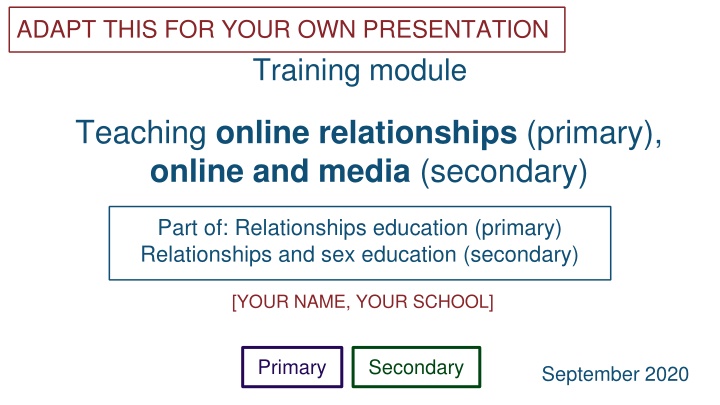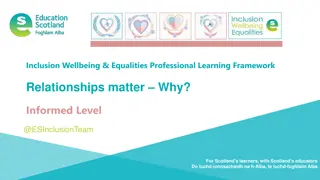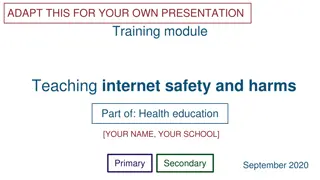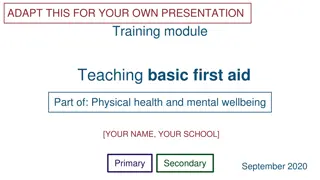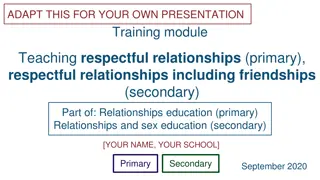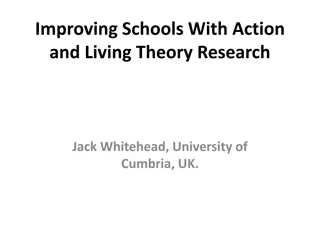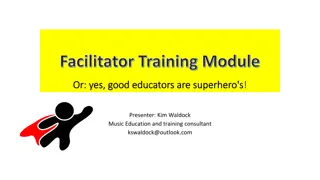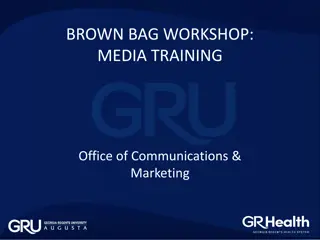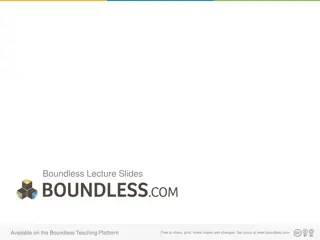Teaching Online Relationships and Media: Training Module for Educators
This training module focuses on teaching online relationships at the primary level and online media at the secondary level. It covers the new curriculum, safeguarding practices, and examples of good teaching. Educators will gain strategies to handle classroom questions and feel more confident addressing topics related to online relationships and media.
Download Presentation

Please find below an Image/Link to download the presentation.
The content on the website is provided AS IS for your information and personal use only. It may not be sold, licensed, or shared on other websites without obtaining consent from the author.If you encounter any issues during the download, it is possible that the publisher has removed the file from their server.
You are allowed to download the files provided on this website for personal or commercial use, subject to the condition that they are used lawfully. All files are the property of their respective owners.
The content on the website is provided AS IS for your information and personal use only. It may not be sold, licensed, or shared on other websites without obtaining consent from the author.
E N D
Presentation Transcript
ADAPT THIS FOR YOUR OWN PRESENTATION Training module Teaching online relationships (primary), online and media (secondary) Part of: Relationships education (primary) Relationships and sex education (secondary) [YOUR NAME, YOUR SCHOOL] Primary Secondary September 2020
Contents 3 About this training module 5 Teaching the new curriculum 15 Safeguarding 18 Ground rules 21 Primary curriculum 55 Secondary curriculum 83 Examples of good practice 89 Activities and templates for trainers 2
About this training module Subject leads can use the adaptable slides and activities and templates for trainers section at the end of this module to help shape training sessions for teachers. This non-statutory training module supplements the statutory guidance on teaching online relationships (primary), and online and media (secondary), which schools should read in full. Schools can choose whether and how to follow or adapt this training module and should refer to the Early Career Framework for pedagogical guidance. 3
What you get out of today By the end of this training you should: know what is included in the statutory guidance know some key knowledge and facts to cover as part of this topic have strategies to deal with questions that come up in class feel more confident teaching about online relationships, and online and media 4
Related topics Online relationships (primary) and online and media (secondary) are closely related to the computing programmes of study as well as to: internet safety and harms other topics such as respectful relationships, being safe and mental wellbeing Therefore, you should: consider thematic links across key topics and the whole school when planning and delivering lessons find ways to link knowledge and vocabulary across topics 6
Related guidance Schools may also want to refer to the following related guidance when planning to teach this subject: Education for a connected world Teaching online safety in schools Guidance for schools on preventing and responding to bullying (including cyberbullying) 7
Online support at [school name] Our leads [Names, contact details - e.g. IT lead] Our policies [Add details - e.g. school policy on PSHE, training opportunities] Specialist support [Add details - e.g. providers school already works with] Other information [Add resources] 8
Online teaching at [school name] Ways in which we already teach about [online relationships / online and media] at our school: [add details] [add details] [add details] 9
Role of the internet in pupils lives From September 2020 schools must have regard to the new statutory guidance for teaching about online relationships. The guidance explains the significant role the internet plays in pupils lives. STATUTORY GUIDANCE Today s children and young people are growing up in an increasingly complex world and living their lives seamlessly on and offline. This presents many positive and exciting opportunities, but also challenges and risks. In this environment, children and young people need to know how to be safe and healthy (p4) 10
Primary and secondary teaching Some slides in this training have a Primary or Secondary label to indicate that the material is usually first introduced in that phase. STATUTORY GUIDANCE Schools have flexibility to design and plan age-appropriate subject content. (p31) Using your knowledge of your pupils and school community you can: introduce secondary content in primary with pupils who need it and are ready teach the primary content in early secondary lessons to pupils who need to build knowledge before secondary content is taught 11
LGBT needs and inclusion Primary schools are enabled and encouraged to cover LGBT (lesbian, gay, bisexual and transgender) content if they consider it age appropriate to do so. Secondary schools should include LGBT content. When doing so, schools should ensure: LGBT-relevant knowledge and examples are included throughout programmes of study (not one-off teaching) inclusive language is used, considering how individual pupils may relate to particular topics 12
Pupils with SEND You will need to plan lessons to allow all pupils to access and practise the core knowledge, using your expertise as you normally would. You might want to link lesson outcomes with statutory preparing for adulthood outcomes for those with an education, health and care (EHC) plan. (See SEND code of practice, section 8.) STATUTORY GUIDANCE In special schools and for some SEND pupils in mainstream schools there may be a need to tailor content and teaching to meet the specific needs of pupils at different developmental stages. As with all teaching for these subjects, schools should ensure that their teaching is sensitive, age-appropriate, developmentally appropriate and delivered with reference to the law. (p15) 13
References to the law The references to the law in this module are given as a teacher resource if needed. They are not exhaustive. Teachers are not expected to be able to teach the details of the law or to be able to answer complex questions that may come up about the law. 14
Safeguarding 15
Safeguarding Pupils may be affected by issues discussed in lessons. Let your designated safeguarding lead or deputy and any other relevant staff, such as pastoral leads, know what you are teaching. This will enable them to identify and speak to relevant pupils, especially those who they know may have been directly impacted by issues covered in the lessons and those with adverse childhood experiences. Teachers may need to deal with disclosures or concerns (e.g. of abuse or offending behaviour) in a way that safeguards pupils in line with school policies, especially the child protection policy. 16
Trusted adults Within this module we have used the term trusted adult. A trusted adult will generally be someone who children feel comfortable to turn to for help. Obvious examples include family members, teachers and doctors. It will be important when teaching this topic, and any other relevant topics, that teachers explore this concept. Pupils should be comfortable and capable of identifying who their trusted adults could be and, importantly, know it is always acceptable to have more than one trusted adult to speak to if for any reason they are uncomfortable or unhappy. 17
Ground rules 18
Create class ground rules Clear class ground rules can help when teaching about sensitive topics. They also support confidentiality and safeguarding of pupils. Good practice is for ground rules to be: discussed and understood by all clear and practical modelled by the teacher followed consistently and enforced updated when needed visible in lessons (for example, posters) 19
Example ground rules Respect privacy. We can discuss examples but do not use names or descriptions that identify anyone, including ourselves. Listen to others. It is okay to disagree with each other, but we should listen properly before making assumptions or deciding how to respond. When disagreeing, challenge the statement not the person. No judgement. We can explore beliefs and misunderstandings about a topic without fear of being judged. Choose level of participation. Everyone has the right to choose not to answer a question or join discussion. We never put anyone on the spot (no personal questions or pressure to answer). 20
Understanding the online world STATUTORY GUIDANCE Know that people sometimes behave differently online, including by pretending to be someone they are not. Begin teaching by recognising that online interactions are an important and often hugely positive aspect of our lives. Alongside this, teachers should empower pupils to recognise the potential risks of online relationships and content and explain some of the strategies we can use to stay safe online. Teachers should note that the separate topic internet safety and harms (health curriculum) also includes content on issues such as rationing time online and age-restricted sites and media, including gambling. Primary 23
How people behave online STATUTORY GUIDANCE Know that people sometimes behave differently online, including by pretending to be someone they are not. Teach pupils that people sometimes behave differently online. This could include saying or doing things that they would not do offline. Reasons for this can include: people feeling more (or less) confident or comfortable than they are offline - e.g. starting a conversation with someone unknown online being unknown to others online or even anonymous (sometimes makes people behave irresponsibly) games, social sites and other online contexts that encourage people to behave in different ways Primary 24
Misleading online identities STATUTORY GUIDANCE Know that people sometimes behave differently online, including by pretending to be someone they are not. Teach that there is a difference between keeping our identity private online and deliberately deceiving people. Explain that it is not ok to impersonate someone else to deceive or bully another person. Emphasise that sometimes people do mislead people into thinking that they are someone else, for example by: creating a false profile, e.g. using someone else s photograph and false details such as age or gender pretending they know you, or your friends/family Explain that someone can always tell a trusted adult if they are unsure about something that happens online. Primary 25
Respectful online relationships STATUTORY GUIDANCE Know that the same principles apply to online relationships as to face-to face relationships, including the importance of respect for others online including when we are anonymous. Introduce the concept of digital citizenship . Teach that the same principles apply to being a good citizen online as offline, including when we are anonymous, such as: having respect for others - valuing differences, being kind and caring having respect for ourselves, our boundaries and privacy - valuing things that make us unique, knowing we deserve kindness and respect Respect means considering the feelings and boundaries of others. It does not mean we have to agree all the time, or that our rights and needs are not important. Primary 27
Communicating online (1) STATUTORY GUIDANCE Know that the same principles apply to online relationships as to face-to face relationships, including the importance of respect for others online including when we are anonymous. Reflecting on how people communicate differently with others offline (e.g. friend, grandparent, teacher) teach that it is sometimes appropriate also to do this online. Also explain that people can easily misunderstand each other online, e.g. because we might not: see facial expressions or gestures (so we might not know the impact we have on others) hear the tone of someone s voice, e.g. to tell if they are serious or joking use the same words we would use in person, e.g. when sending a short text message Primary 28
Communicating online (2) STATUTORY GUIDANCE Know that the same principles apply to online relationships as to face-to face relationships, including the importance of respect for others online including when we are anonymous. Explain that, as with face-to-face conversations, when we are online we need to: take turns - e.g. in an online video conversation reply to someone - e.g. if they could reasonably expect a reply be patient and polite if people do not respond how and when we want - we do not always know what is going on in other people s lives be aware that sometimes people say things that another person could easily misunderstand Also remind pupils that it is important not to exclude people who may not be online as frequently as others. Primary 29
Assessing online friendships and sources of information 30
Assessing online friendships STATUTORY GUIDANCE Know how to critically consider their online friendships and sources of information including awareness of the risks associated with people they have never met. Teach pupils how to critically assess online friendships. Explain that in a positive online friendship a friend will respect boundaries and privacy, for example: maintain trust - e.g. not sharing information with others that we would not want shared be kind and respect that we have our own views even if they disagree not try to control what we say or who else we are friends with not pressure us to do things we do not want to do Related topic: respectful relationships includes more on how to recognise healthy and unhealthy friendships. Primary 31
Understanding online information STATUTORY GUIDANCE Know how to critically consider their online friendships and sources of information including awareness of the risks associated with people they have never met. Teach that although there is lots of useful material on the internet, there is also material (including written information, images and videos) that is: poor quality or out of date deliberately untrue or misleading (e.g. edited images) illegal Teach pupils to recognise the intent of different online material. For example, some material is designed to get us to do things like spend money, give away personal information, or to believe certain things. Primary 32
Deciding what information to trust STATUTORY GUIDANCE Know how to critically consider their online friendships and sources of information including awareness of the risks associated with people they have never met. Tell pupils about some of the ways people can find more reliable material online, including using a combination of the following: established, reputable websites (e.g. GOV.UK) secure websites (e.g. URLs beginning with https ) checking for a padlock in the URL bar, which means any data being exchanged is encrypted checking the publication date of information assessing whether information is factual or opinion cross-checking other websites and offline sources discussing what we have read or seen with others, such as peers or a trusted adult Primary 33
Internet cookies STATUTORY GUIDANCE Know how to critically consider their online friendships and sources of information including awareness of the risks associated with people they have never met. Teach that internet cookies are a technology used to track behaviour online. Websites must ask permission to store these small data files on our devices. If cookies are enabled sites can, for example, show targeted adverts, automatically log us in, or show us more relevant content. Know how information and data is shared and used online. Explain that we can choose to accept or reject the use of cookies on different websites. Primary 34
Echo chambers STATUTORY GUIDANCE Know how to critically consider their online friendships and sources of information including awareness of the risks associated with people they have never met. Teach pupils the concept of an echo chamber . This is when what we see online only includes beliefs or opinions that are the same as and reinforce our own. This can happen through: our selection of friends with similar views to our own our interaction with the same type of online information over time Know how information and data is shared and used online. Primary 35
Keeping safe online (1) STATUTORY GUIDANCE Know the rules and principles for keeping safe online, how to recognise risks, harmful content and contact, and how to report them. Explain that there are principles we can use to help recognise risks and keep ourselves and others safe online. These include: being aware of our boundaries, privacy, and knowing that we have the ability to give and withdraw consent (permission) paying attention to how we feel particularly if we feel anxious or upset about something or someone, or are obsessing about something seen online always talking to a trusted adult if we are unsure about something or someone online Primary 37
Protecting personal information STATUTORY GUIDANCE Know the rules and principles for keeping safe online, how to recognise risks, harmful content and contact, and how to report them. Teach that personal information can be used in harmful ways, so it is sensible to be very careful about sharing: contact details, e.g. phone numbers, email other personal details, e.g. school, daily routine security information, e.g. password, birthday personal images (these can contain information that allows people to identify someone e.g. school uniform shown in a photo or on a live camera) Demonstrate how to use privacy settings on online services, as well as functionality such as blocking users and disabling comments. Primary 38
Harmful online content STATUTORY GUIDANCE Know the rules and principles for keeping safe online, how to recognise risks, harmful content and contact, and how to report them. Ensure pupils know, at an appropriate age, boundaries of acceptability for violent and sexual content (images and words). Teach pupils to tell a trusted adult if they accidentally see or download such content. Teachers should take care to: avoid inadvertently drawing attention to the existence of such content ensure filtering is always in place to minimise the risks in school Schools can also remind parents about the importance of parental controls for domestic internet access. Primary 39
Helping to avoid harmful content STATUTORY GUIDANCE Know the rules and principles for keeping safe online, how to recognise risks, harmful content and contact, and how to report them. Teach that people can be exposed to harmful content in different ways - e.g. through a message or a link. Ways people can try to avoid harmful content include: not opening or resharing attachments/links we are not sure about (or asking a trusted adult first) not opening or replying to messages from unknown people or organisations not sharing their device camera/webcam with people they do not know (e.g. video chat) turning off a device or app, or closing a window if we see something harmful Primary 40
Harmful behaviour online STATUTORY GUIDANCE Know how to critically consider their online friendships and sources of information including awareness of the risks associated with people they have never met. Teach pupils that sometimes people might behave in ways online that might be harmful to us or other people. This can include: pressuring us e.g. to send picture or videos, to meet offline, or share private information sending us things that make us uncomfortable or that we think should not have been sent bullying us by saying mean things or making us feel bad about ourselves Explain that it is always wrong for someone to behave like this, including friends and people we have not met. Primary 41
Meeting people online STATUTORY GUIDANCE Know how to critically consider their online friendships and sources of information including awareness of the risks associated with people they have never met. Teach that social media sites and games often encourage us to add friends , suggesting people we might know based on data they store about us. Explain that we should be careful about adding a friend we have never met in person. While people do make friends online there are risks and important ways to stay safe online. Also explain that some social media sites, apps and games have age restrictions because not all content is age-appropriate and also to keep young people safe. Primary 42
STATUTORY GUIDANCE Know how to critically consider their online friendships and sources of information including awareness of the risks associated with people they have never met. Defining strangers online Teach that a stranger online is anyone we have not met in person. This could be someone who: contacts us on social media or in an online game we have an online friendship with but have not met says they know us, our friends or our family, but that we have never met offline Teach that being polite does not mean we have to reply to a stranger. It is also not rude to stop talking to someone who makes us feel uncomfortable. Pupils should tell a trusted adult if they are unsure of someone they have met online. Primary 43
Danger of meeting strangers (1) STATUTORY GUIDANCE Know how to critically consider their online friendships and sources of information including awareness of the risks associated with people they have never met. Emphasise the danger of meeting someone in person that we have only talked to online and that pupils must never do this. Pupils should always tell a trusted adult if someone they have only met online starts asking to meet in person, or pressures them to share personal information or images. Everyone has the right to feel safe and to tell a trusted adult if they are concerned. People who may want to harm children sometimes say not to tell trusted adults about them and to keep things secret. Primary 44
Danger of meeting strangers (2) STATUTORY GUIDANCE Know how to critically consider their online friendships and sources of information including awareness of the risks associated with people they have never met. Explain that it is very dangerous to meet someone we have only spoken to online because they: might not be who they say they are, e.g. they might be older or look very different might not be someone we can trust might not be a good person might say that there will be a group of people or a party but could be lying This applies even if it is someone we have been chatting to for a long time who we feel like we know. Primary 45
How information is shared (1) STATUTORY GUIDANCE Know how information and data is shared and used online. Teach older pupils that the internet is a series of connected computers. When data (information and images) is put on social media, for example, it is on the internet and could be viewed by lots of people. Some websites have privacy settings that help to control who sees information we share. These can be useful but may not be 100% effective so we must be careful about what information we put online. Teach that if other people can see our information and images, they can be taken without our permission, shared with others, and may be impossible to remove. Primary 46
How information is shared (2) STATUTORY GUIDANCE Know how information and data is shared and used online. Explain that we should never share information or images that we do not want others (and potentially many others) to see. (Includes sending on a mobile.) Although we might just share with one person, they could share the information or image further and in ways that are impossible to control. It can be very difficult to delete information and images that have been shared. Pupils should speak with a trusted adult if they are concerned that they have shared something inappropriate online or if they are concerned about something they have seen. Primary 47
Digital footprint STATUTORY GUIDANCE Know how information and data is shared and used online. Introduce the concept of a digital footprint . Explain that this is a record of our online activities, for example: websites we have visited social media activity private comments which others could re-share Online activities leave a trace that can be seen by others. Primary 48
How information is used STATUTORY GUIDANCE Know how information and data is shared and used online. Begin to teach pupils how information, including information they might share, is used by websites. Many websites and apps track what someone says and shares and then provide that user with: more content that they think will interest them advertising targeted to encourage them to buy things or use services Explain that unlike a book, information online constantly changes. This change is often in response to how the information is being used (e.g. most popular news stories appearing at the top of a website page). Primary 49
